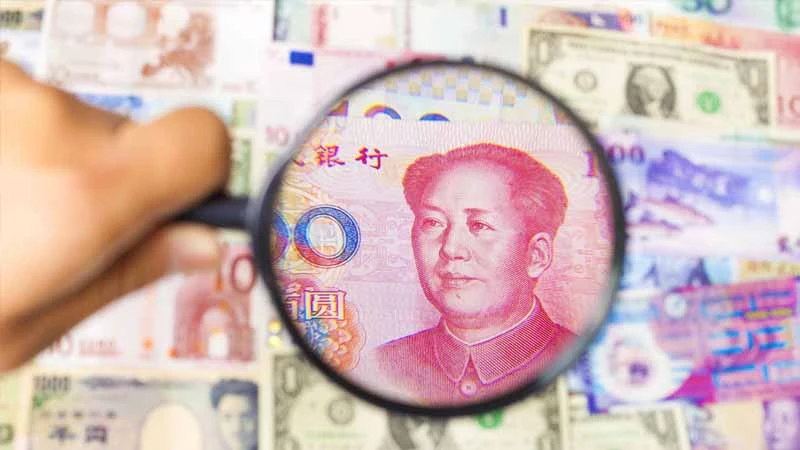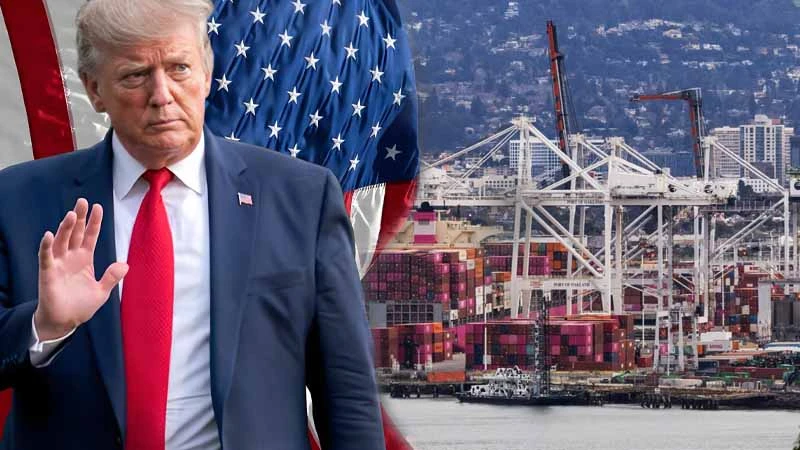Market Signals and Economic Context of RMB Central Parity Rate Devaluation — In-Depth Forex Analysis on February 19, 2025
On February 19, 2025, the China Foreign Exchange Trade System lowered the RMB central parity rate against the USD by 8 basis points to 7.1705. This seemingly subtle adjustment, like the flutter of a butterfly’s wings, has stirred ripples across global financial markets. Against the backdrop of the US Dollar Index breaking strongly above the 107 level and the continued divergence in China-US monetary policies, the targeted loosening of the RMB central parity rate is both a technical response to short-term market pressures and a policy signal guiding two-way fluctuations. Global capital is currently repricing the sustainability of the “double-high dollar” (high interest rates + high valuation), while China’s 4.5% economic growth rate and the safeguard provided by USD 3.1 trillion in foreign exchange reserves give the RMB unique resilience. This article will go beyond the exchange rate figures to deconstruct the triple logic interplay of widening China-US interest rate differentials, trade surplus support, and innovative policy tools, offering cross-border investors a clearer anchor for exchange rate pricing amid the fog.
Event Background and Immediate Market Reaction
On February 19, 2025, the China Foreign Exchange Trade System set the RMB central parity rate against the USD at 7.1705, lowering it by 8 basis points from the previous trading day and marking the largest single-day depreciation in nearly a month. Although the adjustment was relatively mild, in today’s highly sensitive global financial markets it nevertheless drew investors’ attention to the future trajectory of the RMB exchange rate.
Notably, a significant divergence emerged between the spot exchange rate and the central parity rate. As of 9:33 a.m. the day, the onshore RMB (CNY) traded at 7.2820 against the USD, while the offshore RMB (CNH) stood at 7.2835, both more than 1.5% weaker than the central parity rate. This reflects the market’s short-term depreciation expectations for the RMB and underscores the central parity mechanism’s role in managing exchange rate expectations.
Central Parity Rate Adjustment Mechanism and Policy Intent
The RMB central parity rate is determined by a dual-pricing logic combining the “previous closing price + exchange rates changes of a basket of currencies”, reflecting the central bank’s effort to balance market supply and demand with policy objectives. This mild devaluation can be seen as a technical response to the strengthening US Dollar Index while aiming to avoid triggering one-sided depreciation expectations.
Interaction Logic between Onshore and Offshore Markets
The offshore market, due to its higher capital flow freedom, is often regarded as a barometer of international investor sentiment. The current slight discount of CNH to CNY (about 15 basis points) indicates that offshore capital has largely priced in the widening China-US interest rate differential.
Dual Drivers of Economic Fundamentals and Policy Dynamics
The fluctuation of the RMB exchange rate essentially mirrors the interplay between domestic and external economic cycles and policy dynamics. Based on data from early 2025, China’s structural economic adjustments and the shift in US monetary policy constitute the core tension behind exchange rate volatility.
In January 2025, the People’s Bank of China announced the implementation of a “moderately accommodative” monetary policy, marking its first stance shift in 14 years, aimed at boosting domestic demand and stabilizing market confidence. While this move supports the recovery of the real economy, it may intensify pressure on the China-US interest rate differential, thereby affecting cross-border capital flows.
Capital Effects of the Widening China-US Interest Rate Differential
According to analysis by China International Capital Corporation, at the beginning of 2025 the China-US 10-year government bond yield spread had widened to 302 basis points, mainly driven by the dual forces of China’s rate cuts and the rise in US Treasury yields. A widening spread typically triggers carry trades, prompting capital to flow back to US dollar assets from emerging markets, adding depreciation pressure on the RMB.
The Buffering Role of Trade Surplus and Foreign Exchange Reserves
Despite the risk of capital outflows, China’s trade account continues to provide crucial support. In 2024, the annual goods trade surplus reached USD 820 billion, laying the foundation for keeping foreign exchange reserves stable above USD 3.1 trillion. According to Cheng Shi of ICBC International, the scale of foreign exchange reserves is positively correlated with exchange rate stability, which effectively suppresses one-sided depreciation expectations for the RMB under the current environment.
US Dollar Strength Cycle and Global Market Linkage
On February 19, the US Dollar Index rose 0.3% to 107.05, hitting a four-month high and becoming a key factor suppressing non-US currencies. This round of dollar strength reflects both the resilience of the US economy and safe-haven demand amid rising geopolitical risks.
Chain Reaction of the US “Double-High” Policy
The Trump administration’s “high tariffs + tax cuts” policy mix has, on one hand, increased inflation stickiness, forcing the Federal Reserve to delay rate cuts; on the other hand, it has indirectly weakened the competitiveness of RMB-denominated exports through trade barriers. According to forecasts by China International Trust and Investment Corporation Securities, if this policy continues, the RMB may face a dual blow from a “strong dollar + tariff risk” in 2025.
Relative Performance of Major Currencies
Compared with other non-US currencies, the RMB has shown stronger resilience against depreciation. For instance, the euro fell 0.33% against the USD during the same period, while the yen weakened to 151.36, indicating that the RMB’s depreciation has been relatively moderate. This difference reflects the impact of China’s capital controls and the central bank’s expectation management.
Market Expectations and Asset Allocation Strategy Adjustments
Exchange rate fluctuations not only affect hedging decisions of trade enterprises but also reshape global investors’ asset allocation logic. The current onshore-offshore exchange rate spread and cross-border capital flow data both point to strategic adjustments by market participants.
Arbitrage Opportunities Behind Onshore-Offshore Exchange Rate Spread
Although the onshore-offshore exchange rate spread has narrowed from its 2024 peak, it still maintains a price gap of about 0.2%, attracting cross-market arbitrage trades. Companies can reduce currency exchange costs through the strategy of “onshore settlement and offshore purchase”, but they need to be cautious of intervention risks from central bank window guidance.
Dynamic Balance of Foreign Holdings in RMB Assets
In 2024, foreign investors made net purchases of Chinese bonds totaling USD 80 billion, underscoring the hedging attributes of RMB assets. However, data from January 2025 show that overseas institutions reduced their holdings of government bonds by about RMB 12 billion, reflecting short-term profit-taking under the widening interest rate differential.
Medium- to Long-Term Outlook and Policy Response Path
Looking ahead to 2025, the RMB exchange rate is expected to maintain two-way fluctuations under the framework of “stabilizing domestic growth” and “preventing external risks”. The International Monetary Fund (IMF) forecasts that China’s economic growth will remain above 4.5%, providing fundamental support for the exchange rate.
Structural Opportunities in RMB Internationalization
The share of cross-border RMB payments rose to 4.74% in June 2024, and funds deposited in the Hong Kong offshore market exceeded RMB 950 billion, indicating the continuous strengthening of its settlement function. According to a report by China Construction Bank, the cross-border application of digital RMB may become a new breakthrough for internationalization.
Innovation and Coordination of Policy Tools
The People’s Bank of China has stated it will “strengthen expectation management” and “expand government bond purchases”, using unconventional tools to mitigate the risk of exchange rate overshooting. Industrial and Commercial Bank of China International suggests that expanding bond market access and deepening currency swap agreements could enhance the attractiveness of RMB assets.
Conclusion
This mild adjustment of the RMB central parity rate is both a technical response to the strong US dollar and a reflection of policymakers’ determination to stabilize the exchange rate. Against the backdrop of diverging global economic cycles and intensifying geopolitical tensions, the flexibility and resilience of the RMB exchange rate will continue to be tested. For investors, it is essential to closely monitor the China-US interest rate differential, trade data, and central bank policy signals to capture structural opportunities amid volatility.
Frequently Asked Questions
Q1: Why was the RMB central parity rate lowered on February 19, 2025?
The adjustment mainly reflected two factors: first, the US Dollar Index strongly broke above the 107 level, prompting a technical correction in RMB pricing; second, after the People’s Bank of China initiated a “moderately accommodative” monetary policy, the widening China-US interest rate differential increased capital outflow pressure, and the mild adjustment of the central parity rate aimed to balance market expectations.
Q2: How does the China-US interest rate differential specifically affect the RMB exchange rate?
According to data from China International Capital Corporation, at the beginning of 2025 the China-US 10-year government bond yield spread reached 301 basis points. The widening spread prompted international capital to flow into US dollar assets, creating depreciation pressure on the RMB. However, China’s trade surplus (USD 820 billion in 2024) and USD 3.1 trillion in foreign exchange reserves provide a buffer.
Q3: How should ordinary investors respond to RMB fluctuations?
It is recommended to monitor three key indicators: ① The onshore-offshore exchange rate spread (reflecting market sentiment); ② Changes in the China-US interest rate differential (affecting capital flow direction); ③ Central bank policy statements (such as adjustments to the foreign exchange risk reserve ratio). In the short term, moderate allocation to USD-denominated hedging assets is advisable, while in the medium to long term, RMB-denominated bonds remain a viable option.
Q4: How long will the strong US dollar cycle last?
According to China International Trust and Investment Corporation Securities, if the US “high tariffs + tax cuts” policy continues, the Federal Reserve may delay rate cuts, and the strong US dollar could persist through the first half of 2025. However, China’s economic growth (IMF forecasts above 4.5%) and innovative policy tools (such as the cross-border application of digital RMB) will limit the room for one-sided dollar appreciation.
Q5: What is the impact of RMB depreciation on import and export companies?
For export companies, RMB depreciation can enhance price competitiveness, but they need to be cautious of tariff barriers in Europe and the US offsetting this benefit. Import companies, on the other hand, face rising cost pressures and can use tools such as forward exchange settlement and sales or option combinations to hedge exchange rate risks.
Related articles
-
Since 2025, global financial markets have continued to focus on the monetary policy trends of the US Federal Reserve (Fed) and movements in the US Dollar Index. As a barometer of the international market, the performance of the US Dollar Index (DXY) directly affects asset prices and capital flows in...2025 年 3 月 18 日
-
2024 Q4 US Nasdaq Index plunged 3.6%, while the Hang Seng Tech Index fell 4.2% simultaneously, highlighting that the linkage between the two markets has deepened to the level of capital flows. Facing the Federal Reserve’s policy swings, the tech industry’s cyclical shifts, and rising geopolitical risks, Hong Kong stocks...2025 年 2 月 21 日
-
In February 2025, Donald Trump's 25% tariff on imported cars triggered an instant earthquake in the global supply chain. This trade policy, which has been labelled “America First 2.0", has not only forced multinational car companies to urgently reorganise production, it has also pushed the price of precious metals past...2025 年 2 月 21 日













